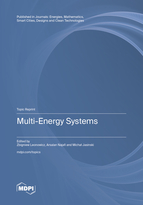Topic Menu
► Topic MenuTopic Editors

2. Faculty of Electrical Engineering and Computer Science, VSB-Technical University of Ostrava, 708-00 Ostrava, Czech Republic


2. Faculty of Electrical Engineering and Computer Science, VSB-Technical University of Ostrava, 708-00 Ostrava, Czech Republic
Multi-Energy Systems

A printed edition is available here.
Topic Information
Dear Colleagues,
Industrial/commercial centers and residential consumers require different types of energy such as electrical, heat, and natural gas. Nowadays, many types of energy resources are available. Traditionally, energy is operated and planned separately, but their combination may be synergistic. Hence, penetration of multi-energy systems has been raised in the real world, e.g., co-generation combined heat and power systems. The process of combining various types of energy is also called a multi-carrier energy system, which increases energy efficiency. In addition, the rapid development of technologies has resulted in amplifying the joint operation of the multi-generation systems. This highlights the importance of focusing on multiple alternatives such as integration of renewable energy sources, effective energy conservation, energy storage, etc.
The main purpose of the proposed topic is to cover research in electrical, mechanical engineering, and thermal sciences, with a strong concentration on multi-energy analysis, integrated energy systems, multi-energy systems modeling, operation and planning of integrated energy systems, energy conversion, efficiency, renewable energy and electricity supply, including small and large demand scales. It also welcomes research on the technologies of energy storage and electric vehicles.
Topics of interest include but are not limited to:
- New approaches for the operation of multi-energy systems, especially investigation of economic aspects;
- Planning of multi-energy systems, including optimal determination of devices in the systems;
- Applying heuristic and mathematical models for optimal energy management of the energy systems;
- Nonlinear dynamics in multi-energy systems, as well as renewable energy systems;
- New approaches to control the energy storage of renewable energy systems;
- Investigating new operation and planning technologies for the future penetration of electric vehicles in the power grid.
Prof. Dr. Zbigniew Leonowicz
Dr. Arsalan Najafi
Dr. Michał Jasinski
Topics Editors
Keywords
- multi-energy systems
- integrated energy systems
- renewable energy
- operation
- planning
- electric vehicle
- energy storage
- smart grid
- electricity market
Participating Journals
| Journal Name | Impact Factor | CiteScore | Launched Year | First Decision (median) | APC |
|---|---|---|---|---|---|

Energies
|
3.2 | 5.5 | 2008 | 16.1 Days | CHF 2600 |

Mathematics
|
2.4 | 3.5 | 2013 | 16.9 Days | CHF 2600 |

Smart Cities
|
6.4 | 8.5 | 2018 | 20.2 Days | CHF 2000 |

Designs
|
- | 3.2 | 2017 | 16.4 Days | CHF 1600 |

Clean Technologies
|
3.8 | 4.5 | 2019 | 26.6 Days | CHF 1600 |

MDPI Topics is cooperating with Preprints.org and has built a direct connection between MDPI journals and Preprints.org. Authors are encouraged to enjoy the benefits by posting a preprint at Preprints.org prior to publication:
- Immediately share your ideas ahead of publication and establish your research priority;
- Protect your idea from being stolen with this time-stamped preprint article;
- Enhance the exposure and impact of your research;
- Receive feedback from your peers in advance;
- Have it indexed in Web of Science (Preprint Citation Index), Google Scholar, Crossref, SHARE, PrePubMed, Scilit and Europe PMC.

